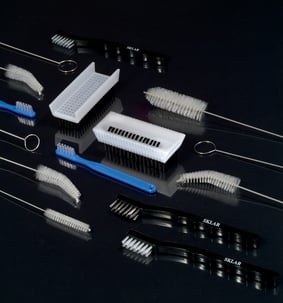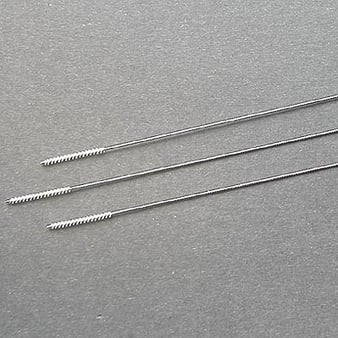One of the key components in medical instrument cleaning is using the appropriate brush. With so many available options in the market today, it is important for staff to use the right brush to clean instruments thoroughly. Technicians should be familiar with the length and gauge of the brush, and which bristle types should be used on each specific device. Here are some helpful tips:
- Nylon –This material is the most durable synthetic filament available. It has excellent abrasion and bristle bend recovery. Nylon resists most acids and will not scratch most surfaces.
- Polypropylene – This is one of the most chemically resistant synthetic materials, particularly strong with acids and bases. Since it does not absorb moisture, it resists fungi and bacteria, and sheds dirt easily.
- Stainless Steel – This type of bristle is highly resistant to corrosion, heat and chemicals. It should not be used on insulated or coated instruments because it may damage them. Stainless steel is designed to clean instruments that have serrations or box locks.
There are several guidelines that have been established regarding best practices for cleaning medical instruments and devices. These include the ones published by the AST (Association of Surgical Technologies), the ANSI (American National Standards Institute, Inc.) and the AAMI (Association for the Advancement of Medical Instrumentation).
 Manual cleaning is recommended for delicate instruments and devices, such as microsurgical instruments, lensed instruments, power equipment and other instruments that can’t tolerate an automated cleaning process.1 For these delicate instruments, Sklar recommends using a nylon-bristled brush first. If debris still remains on the instrument, then use a stainless steel brush.
Manual cleaning is recommended for delicate instruments and devices, such as microsurgical instruments, lensed instruments, power equipment and other instruments that can’t tolerate an automated cleaning process.1 For these delicate instruments, Sklar recommends using a nylon-bristled brush first. If debris still remains on the instrument, then use a stainless steel brush.
Stainless steel brushes are designed to remove debris, stains and stubborn bioburden that the nylon brush can’t remove. Stainless steel is intended to be used on bone files, needle holders, burs, hemostats, reamers, scissors, serrated vascular instruments and orthopedic instruments.
Brush Sizes and Usage
Medical instruments come in many shapes and sizes, so it is imperative for SPDs (Sterile Processing Departments) to have a full assortment of brushes specifically designed to clean them properly. For example, a brush too small for a cannula may result in inadequate cleaning, since it doesn’t provide the necessary scrubbing action. Conversely, using a brush that is too large makes the bristles lay against the wall of the lumen. Even worse, the brush may become stuck inside the channel, ruining both the device and the brush.2 Sklar recommends the brush diameter be no more than 1/8” larger than the channel. The bristle should be able to make contact with all the walls of the cannula at the same time. Pictured are Sklar’s suction tube cleaning brushes which have been specifically designed to use with Baron and Frazier suction tubes. They are available in a number of narrow brush tips to accommodate any Baron or Frazier tube.
 Shown here, 1.6mm wide brush tip and overall length of 6 inches
Shown here, 1.6mm wide brush tip and overall length of 6 inches
The AST emphasizes: “only brushes designated for use in cleaning instruments and devices should be purchased by the healthcare facility. Reusable brushes create a risk for cross-contamination, and should be cleaned and decontaminated at least daily or when heavily soiled. Brushes that show wear should be discarded.”3
It is very important for technicians to visually inspect brushes after each use. Brushes with flattened or out bristles should be discarded and replaced.
If you would like to learn more about Sklar's brushes and cleaning products, please click the button below.
References:
1 AST Recommended Standards of Practice for the Decontamination of Surgical Instruments. Section 4.2ANSI/AAMI ST79:2010, section 7.5.3
2 AST Recommended Standards of Practice for the Decontamination of Surgical Instruments. Section 4.2 E-2ANSI/AAMI ST79:2010, section 7.5.6
3 AST Recommended Standards of Practice for the Decontamination of Surgical Instruments. Section 4.2 E-1



